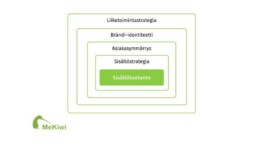How to improve your website visibility?
You have web pages, but they don’t appear in your browser’s search results. This is a pretty common problem. It is often assumed that the marketing effort has been made once the website has been launched. Websites must be kept alive. They need updating from time to time, e.g. new content and internal and external linking.
How to do SEO?
SEO (Search Engine Optimization) is a process that improves the website visibility in relation to competitors’ ones. Website visibility is affected by the technical functionality of the site, search engine optimized content, company brand awareness, and user personalization. Personalization can be increased, for example, through product suggestions and retargeted advertising to the user of the site. In this blog, we will focus on producing search engine optimized content.

What is search engine optimized content like?
It is worth thinking about what are the strategic customer groups. What kind of customers do you want to market the services to? Who are the potential customers? What kind of needs do they have?
On the other hand, what kind of needs do we have ourselves? What services do we want to provide? What kind of leads do we want to achieve? How are target groups informed about their own values and goals? How would organisations, unions and associations improve the recruitment of new members, for example? Based on these questions, you can already guess what kind of content should be on the website.
In addition to strategy and customer orientation, one of the goals of website design is the visibility of the pages, i.e. search engine optimized content. However, before producing content, you need to find the most common search terms, i.e. keywords.
How to find keywords that work?
Keywords are the very words that customers use to find a solution to their needs. So step into the customer’s shoes yourself and start googling the service you want to find and know about. This allows you to find the best keywords and the most common questions that customers have used when searching for the service.
Customer orientation, natural questions, keywords and linking enhance the findability of the website. Search engine optimised keywords are not just a list of words in the content, they are embedded in the titles and text. The main thing is the clarity and interest of the text from the customer’s point of view.
The most important keyword is the one around which the content is built. Other keywords, on the other hand, support the topic substantially. You can’t fool the search engine, so you shouldn’t overuse keywords. A good ratio is one keyword per 20 words. Services are also often sought with questions. Questions are great keywords. They can be used in content titles. From the keywords you can create the so-called keyword map to help write the rest of the content.
Keywords and content writing
Keyword lists are not yet content, but pages should provide customers with expert and interesting content. It must also be salesy and support the customer’s path to purchase. The website may contain, for example, product information about products, test results and customer quotes about the use of the product. The content of the services includes service descriptions, pictures, maps, customer stories and customer quotes about the service. The sites of organisations etc. provide members with relevant information on their activities.
Whose job, then, is it to produce content? You can entrust content creation to professionals if you don’t have the time and know-how to do so. The professional knows how to write clear, interesting and sales-promoting text. However, you are a service provider and know more about your services than an outsider. Therefore, you should participate in content production as an expert, and provide information and comment on content produced by an outsider.
What is the meta description?
The website is made more interesting by the meta description, i.e. the metatext, which appears as text that describes the content of the web page when the browser’s search results are listed. The aim of the description is to capture your interest and make you want to explore the site in more detail.
The role of meta description is significant, so it is worth investing in it. The description is written in a customer-oriented manner. Let’s think about what a potential customer wants to know and consider the answers to them. The more interesting the description, the more likely it is that the customer will click on the site.
Is your search engine optimization up to date? As digital marketing experts, we can improve the discoverability of your business website.
We get acquainted with the technical implementation of your company’s website and the optimization of services and keywords. We create an overall picture of the development project for you, what we do, how we proceed and what we achieve together.
Read also our previous blog, How do I produce meaningful content?
Want to know more about external links? You can check the MOZ website.
How do I create meaningful content?
Content is always produced for the customer. It needs to reach the right customers and address them in the right way. Business strategy, brand and customer understanding are the cornerstones of content production. They give the content a strategic direction, a way of working and communicating, and create value for the customer. The key to meaningful content production are buyer personas, the purchase paths created for them, timely content and content linking from different channels to websites.
How do I strategically produce the right content?
Content marketing is part of a company’s marketing strategy. In the same way as the marketing strategy and the marketing plan that implements it, the content strategy and content production also follow the business strategy of the company. In this way, the organisation works in harmony towards the goals set.
Strategically, we know, for example, to whom, what, how and where we market and sell. From the perspective of a content strategy, it is meaningful to know what kind of buyer personas we want to reach, engage and serve, and how we manage content in different channels and websites. When content is created around the problems and goals of the buyer persona, sales grow, the brand is strengthened, and our company succeeds.
For the overall brand of the company, it is important that the communication is in line with the brand. The communication of brand identity and value proposition is reflected in all communication, so it should not be forgotten in content production either. The contents consistently reflect the company’s personality, way of working and communicating. Brand should manifest itself in all forms of communication, both visual and spoken content. Consistency of communication increases the credibility of the company in the eyes of the client.

How do I add customer focus to content production?
The better we understand the customer, the easier it is for us to produce content. Customer research provides valuable information for defining buyer personas and the factors that guide a purchase decision. The goal of customer orientation is to create value for the customer with every channel and content. Well-executed content is interesting, informative and motivating for the customer and supports the purchasing process. They also improve the interaction and cooperation between the customer and the company.
The content creator is particularly interested in the customers’ purchasing and service experiences. Purchasing services requires expertise and is often challenging for the customer. Customer satisfaction and efficient and profitable sales are best realised when the customer’s purchase path and the company’s sales path go hand in hand. The client is provided with useful content in a timely manner at different stages of the purchase path.
Customers can be provided with more relevant content that facilitates and speeds up the buying process. For example, a website can create a unique purchase path for each buyer persona. At the beginning of the customer’s purchase path, the task of content production is to support the findability of the website and the intelligibility of the content of the service descriptions. Content linking and search engine optimised content help the customer find the company’s services. The content of the website should provide information and support the customer in the purchase process. Meaningful content entices the customer to progress from one content to another and leads the customer towards a purchase decision.
Is your content creation relevant? At MeKiwi, we use service design to study customer experience and develop the digital purchase path. As digital marketing experts, we can help your company develop content production. We look at your company’s goals and needs. We create an overall picture of the development project for you, what we do, how we proceed and what we achieve together.
Signs of top-notch customer service
There is no business without customers and keeping good relations with them is vital for every company. Word-of-mouth advertising should not be underestimated, it affects your brand for better or worse. The brand of a company is built on how customers see it, not from how the company sees itself. A top-notch customer service covers how to provide the best possible customer experience.
Product knowledge inside and out
One essential point of delivering good service is the knowledge of the product. Think about someone trying to sell you something they know nothing about. That does not give a very good impression now, does it? Make sure your employees know the business, and what they are selling, to provide a better experience for the customer. Motivate employees to get to know the business and services more by arranging workshops or weekly meetings. After all, employees are the ones who represent your brand.
Step in the customer’s shoes
When you are presenting your products or services to the customer, they don’t want to hear what you do, they are interested in how they will benefit from your service. The best customer service highlights what you really can offer to their business in terms of value. When thinking about value, pricing the service right is one key point. Also make sure that the product or service is what you describe it to be.
Try seeing things from the customer’s point of view, listen to them carefully and together try to find just the right solution for them. You want to keep your clients happy and make them also want to come back. Treat your clients kindly and don’t talk down to them, no matter how hard the situation is. Don’t forget, communication is the key!
Keep the schedule in mind
A good customer experience involves good planning, so before your team storms into a new project make sure that the scheduling is done properly. Dividing tasks into smaller sprints gives everyone a better overview of what is going on and what is going to happen next. Deliver the project in time, you don’t want to make your client wait for too long. In case your company’s internal communication needs improvement, we already got you covered. Go check our post for tips onhow to make your company’s internal communication work.
Keep also communicating with your customers, be reachable and give updates how the project is progressing and provide them material along the way to get the feedback. Make the desired changes to meet the expectations, but bear in mind the budget, schedule and if the changes are possible overall. You are the expert of your field and the client doesn’t always know the best practices of how things are supposed to be done. It is your job to provide the correct information needed to keep the project on track.
Believe in client questionnaires
After you finish a project, send a satisfaction survey to the client to get immediate feedback. This ensures that you are going in the right direction with your customer service and helps to improve your business. You can utilize the given feedback to promote your brand and services.
Interact with your clients through social media
Last but not least, using social media effectively is a part of delivering good customer service. Publish content what targets your desired audience, what might answer their burning questions and get them motivated to contact you. Choose the right platforms for you and try to keep them active and be responsive in the comments.
The subjects on this post are only the tip of the iceberg but will help you create a more meaningful relationship with your customers.
Tips for remote conferences
In the current global situation, remote conferences and fairs have begun to grow in popularity, bringing new challenges to company’s sales representatives.
Connection problems and staring at the screen can seem numbing and people can easily distract themselves with news or by browsing social media, reducing effective participation. We decided to share with you a few tricks that our VR Account Manager Aatu Numminen collected to make the most out of this new way of networking.

Focus on your goals - Just like at a traditional fair, the most important thing for a productive day is clear goals. Looking for leads or to find new perspectives? Plan your day accordingly! If you’re working with your colleagues, sharing tasks will help a lot.
Lead Hunting - Most remote conferences use chats as part of presentations, giving companies the opportunity to discuss the topic. “It’s easy to move such conversations to LinkedIn, for example, and making networking happen naturally.”

Multiverse - Remote fairs can let you participate to multiple talks at the same time on the speakers’ “ virtual stages ”. This lets you network with more people in one day. The most important thing is to find the limit of your own focus so you can keep up with all the conversations.
Endurance - During a computer-based conference there's a risk of forgetting to eat or take breaks. Focusing intensely on a screen can also start to feel heavy. "Personally, I have solved the problem by increasing the volume of the conversations, so I can easily follow them even during a break."
Online services accessibility – what does it mean?
Have you ever visited a website that is confusing, hard to navigate and difficult to use? Sites like the one described above are poorly designed and implemented from an accessibility perspective.
Accessibility refers to how easy a website is to use and understand for the widest possible range of users. This means that accessibility benefits all users. However, it is particularly important for those with a disability or a limitation of some kind. As the population ages at a record rate, it also poses challenges for online services and their design. The new accessibility law for digital services will enter into force in a phased approach from September 2019.
The accessibility of a website depends on the clarity of its content, visual appearance, technical implementation and usability. Accessibility is often associated with the concept of "Design for all", which aims to design and implement solutions that take into account the needs of the widest possible range of users, depending on their use situations and environments.
What are the things to consider when it comes to accessibility?
The accessibility of the content can be improved by using clear general language, avoiding technical terms, and by structuring and titling the text into an easily understandable one. Images with important information should have alternative texts and videos should be subtitled.
From the interface and visual design point of view, the contrasts of colours and tones should be clear enough to make it easy for a visually impaired or colour-blind person to distinguish texts and links from the background. A clear font and a large enough size are also important for good readability.
Technical accessibility means, for example, that the website can be used with technical aids such as reading devices. In terms of the technical implementation of the website, one of the most important things is to ensure smooth navigation using the keyboard tab.
The online service developer may have limited knowledge of the needs of specific groups. To assess and test accessibility, it is therefore worth using real users of the site. Using the expertise of specific groups will undoubtedly bring added value to the development of websites.
Case Sytyke
Here at MeKiwi, we have studied accessibility criteria and practical implementation based on the needs of several customers. In June, we completed our latest website project, where accessibility was one of the key criteria for the client. Sytyke ry, under the umbrella of the Organisation for Respiratory Health in Finland, launched a new accessible website, which we designed and implemented.
Sytyke's customers consists mainly of young adults who have difficulties in managing their lives and face challenges in entering the workforce for various reasons.
The project started with a thorough groundwork, which took into account the needs of the user groups and the basic criteria for accessibility, from the technical implementation, content design and visualisation point of view.
They wanted the site to look fresh, youthful and easily accessible. The images chosen are clear and fit the world of a young adult. The colours used on the website were carefully selected from the Sytyke brand book. Strong colours were chosen for the buttons and texts to make them stand out from the background. The backgrounds of the text areas were kept light in tone and monochrome to maintain good readability and clarity.
The content was divided into easy-to-understand paragraphs, making it easy to find the information you need. The texts were kept as clear and easy to understand as possible, and the amount of text was also reduced, focusing only on the essentials. The end result of the development process was a young, fresh and easy-to-use website.
Sytyke also wanted to test the new pages with visually impaired users to get real feedback on accessibility. User feedback was very positive and visually impaired people rated the level of accessibility and overall user experience as very good.
Check Sytyke's new website here.
EU Accessibility Directive (2016/2102) in a nutshell:
- The Accessibility Directive applies to online and mobile services in public administrations. This includes municipalities, schools and government agencies.
- Water, energy, transport and postal services are also covered. It also applies to institutions that receive government support for online services.
- Websites published after 23.9.2018 must comply with accessibility requirements by 23.9.2019.
- Mobile apps must be compliant with accessibility requirements by 23.6.2021.











